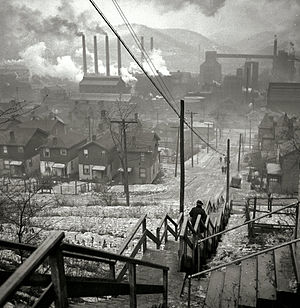
Crawford Grill II (Photo credit: joseph a)
For people who are still asking the question: “Why Pittsburgh?” I would remind them of a very famous place that many jazz aficionados know played a major role during Pittsburgh’s heyday as a jazz capital in the 1940’s and 1950’s. I may have mentioned the Crawford Grill before because the owner was Gus Greenlee, the famous numbers kingpin who also owned the Pittsburgh Crawfords.
The Crawford Grill was the place people came to hear the real jazz music after the downtown clubs, which stayed segregated for years, had closed for the evening. Maybe in the transport, away from Pittsburgh’s business center, people could see a different world. The Crawford Grill was located in Pittsburgh’s Hill District. According to Nathan Thompson in Kings, this was the place where you could find Lena Horne, Duke Ellington, Billy Eckstine, Mary Lou Williams, Earl “Fatha” Hines and many others. The late night was the time when everyone black and white, would show up at The Crawford Grill. The musicians would all jam together and the patrons would all listen together. Quite a different scenario than the segregation that regularly happened just hours before in the “high-tone” white jazz clubs in downtown Pittsburgh.
The Hill District is the uptown area, just above the downtown area. Many don’t know that there were actually three Crawford Grills. This first club was where many of the heavy hitters played. It was located on land that was later occupied by The Civic Arena, the place where the circus would come to town in my childhood years. Of course, now The Civic Arena is gone and there’s just massive blank space where history once existed. The first Crawford Grill was destroyed by fire in 1951. Gus Greenlee died a few months after the fire.
The second location still stands in The Hill District, but it’s all boarded up. It was open until 2001. There’s still a phantom website inviting you to come to lunch there. There have been on and off discussions about opening it back up as a center of black history and culture, but since the August Wilson Center has been struggling, I don’t think that’s going to happen. The third location of The Crawford Grill was in Manchester, across the Allegheny River, but it isn’t there anymore either. I guess Gus Greenlee tried to take the concept as a chain, but in true Pittsburgh style, what works in one neighborhood, might not work so well in another neighborhood.
My discussion about The Crawford Grill as a center of jazz culture and appreciation seems to have a resonating theme that is not so happy. These places of history are like phantoms, gone without appreciation or acknowledgement. Thankfully, the second location of the Crawford Grill has a Pennsylvania Historical Marker. Still, whenever I go back home, I just see a big old parking lot where a lot of history was demolished to make way for an eyesore auditorium that is now gone. When are we going to learn to recognize and appreciate our historical places?

“Earl `Father’ (Fatha) Hines, a great swing musician, is shown with Pvt. Charles Carpenter, former manager of the Hines – NARA – 535834 (Photo credit: Wikipedia)
My music series continues with the people who worked in concert with Mary Lou Williams, featured two weeks ago, and how vital these individuals were to creating a vibrant music scene in jazz in Pittsburgh. This also continues to support the question of “why Pittsburgh” to show the many and varied contributions made by these artists.
Earl “Fatha” Hines played with Mary Lou a lot of the time. Born in Duquesne, which is just up river from Pittsburgh, he took up piano playing because he couldn’t play cornet as his father did. The cornet hurt him behind the ears, so Earl had to take up a different instrument. It’s a good thing for jazz history that he did, because it was on the piano where he composed and developed music. He, like Mary Lou, played widely for pay for various audiences in their youth all over Pittsburgh, allowing them to each develop their singular style. They are both given credit for helping to birth the style of bebop during the 1940’s and take jazz to a whole other lever. Or, jazz historian Linda Dahl puts it in her book on Mary Lou, Mourning Glory, “playing and developing jazz before the term became widely used.”
He left Pittsburgh at 22, but always carried his hometown roots with him as he played with everyone in the business: Charlie “Bird” Parker, Dizzy Gillespie, Louis Armstrong—the list goes on and on. He also owned nightclubs, developed big band combos and helped other musicians develop recordings of their music so they could have some sort of autonomy. Hines represents a change of pace in the early music world in that he had a business sensibility as well as his musician’s temperament—two qualities that don’t often go together.
For me, it is the combination of business acumen and musical talent as an innovator that makes Earl “Fatha” Hines an interesting framework for a potential hero. Oh, and as I was reading about him, I thought his nickname was pronounced as some offhanded way of saying “father” as he was a father of bebop. However it was my own father who corrected me on the pronunciation—highly nasal “Fat-ta,” meant as a name of respect. There are lots of stories about the origins of the nickname, but it certainly must be a corruption of father in some way—the man originated so much in the jazz world, that nothing else really makes sense.
 Every child has a strange old lady story. When I was a child, my peculiar older lady lived two houses away. She put on a lot of airs and was very snobbish. Her young granddaughter used to play with my younger sister, and she was so distant, she couldn’t even be close to her own granddaughter.
Every child has a strange old lady story. When I was a child, my peculiar older lady lived two houses away. She put on a lot of airs and was very snobbish. Her young granddaughter used to play with my younger sister, and she was so distant, she couldn’t even be close to her own granddaughter.
At the time, I didn’t understand that I was bearing witness to the residuals of disappointed dreams. My father, a trained opera singer, knew this older lady in her associations with The National Negro Opera Company headed by Madame Mary Cardwell Dawson (pictured here) founded in Pittsburgh, Pennsylvania. The lady had been a protégé of Madame Dawson’s and once was thought to be a very talented concert pianist who, ultimately didn’t go very far in the concert piano world because of her race and class. She ended up giving piano lessons in the public schools and made her contributions that way.
In the movie Black Nativity, they made repeated reference to Langston Hughes in his poem “Harlem” with the famous line of “What happens to a dream deferred?” In the case of a lot of African Americans, especially those who have been working to break down the color barriers of opera, there has been a lot of deferring to younger people and waiting for a better day.
Unfortunately, the older lady didn’t get very far. My father got a little further than she did and performed in some productions. The young singers now are going beyond his success. Still, it is slow going. I like to think of persevering pioneers like Madame Mary Cardwell Dawson as having great vision. She provided places for her singers to perform Carmen, Aida, Faust, La Traviata and other famous operas during the 1930’s, 1940’s, and 1950’s. The National Negro Opera Company was the first company allowed to perform at the Metropolitan Opera House. Madame Dawson saw herself as providing training for the future teachers of those who would come and sing famous opera roles in integrated circumstances. She gave voice lessons, recruited young singers from churches, formed choirs and went on tours with them to show what they could do. Her choirs, sometimes numbering in the hundreds, won prizes in the 1930’s. Her contributions were recognized in 1961 when President Kennedy named her to the National Music Committee. She died the next year and the company didn’t last long beyond her lifetime.
There are times when dreams may seem very far away. However, we must take comfort from those who came before us. They had very little chance of seeing their dreams come true, but still found another way to make a contribution. We must carry on with their work so that their sacrifices are not forgotten.
Okay, I’ve endured enough jokes. I was asked today, “Why Pittsburgh? Is it because it is the pits?”
Ha! Ha! It’s not as if I haven’t heard that one before, since I’m originally from Pittsburgh ….
Then there were all of those jokes in the movie 42, which was a fine movie except for all the Pittsburgh jokes…
Fortunately, when you hail from Pittsburgh, The Steel City, we can take one on the chin (except for the record for the Steelers this season, they’ve got to do better).
Living away from my birthplace for a number of years has permitted me a perspective of how unique the city is. It is the perfect amalgamation of East coast, Midwest and Appalachian sensibilities. Then, when you throw race and the shifting immigrant population into all of that, the potential for story conflict is huge.
At the time of the beginning of The Great Migration, Pittsburgh was the sixth largest city in the country, a destination place.
And, unbeknownst to me, even as a steel-jawed native, it was quite the destination for jazz. I mean, I knew that Lena Horne grew up here, but it didn’t really register until I did my research.
The story of the development of jazz as well as many other musical forms here, reflects the story of America, a setting that is potentially rich with conflict. So over the next few weeks, I will highlight a few of the figures who put Pittsburgh music on the map and made the city a destination during the years of The Great Migration.
And by the way. If you must know, Pittsburgh is named after a Prime Minister of England, William Pitt the Elder, and no, he wasn’t the pits. He just happened to have an unfortunate name. And the name of the city may be unfortunate, but it is a very special city. Hope you come by and visit sometime.



 Every child has a strange old lady story. When I was a child, my peculiar older lady lived two houses away. She put on a lot of airs and was very snobbish. Her young granddaughter used to play with my younger sister, and she was so distant, she couldn’t even be close to her own granddaughter.
Every child has a strange old lady story. When I was a child, my peculiar older lady lived two houses away. She put on a lot of airs and was very snobbish. Her young granddaughter used to play with my younger sister, and she was so distant, she couldn’t even be close to her own granddaughter.




